In 1995, Audi introduced the slogan “Avant Grade Pioneer” with the release of the RS2 Avant. Nearly 30 years later, on March 17, 2022, Audi unveiled the A6 Avant e-tron concept car, with the production version set to hit the market in 2024.
New Design Language Takes the Lead
People choose Audi primarily for its design, so design is at the heart of our development process for new models. Audi is committed to implementing a timeless, systematic design throughout every aspect of our vehicles: interior, exterior, color, materials, and lighting. Our design language is emotionally expressive and progressively layered, perfectly conveying Audi’s technical capabilities and quality standards to the outside world.
Audi’s next-generation design language, founded on the Grandsphere, echoes Audi’s brand design philosophy, creating a sweeping, elegant, and bold silhouette for the A6 Avant e-tron.


Looking at the wagon from a classic 45-degree angle from the rear, the viewer’s attention is guided toward an aluminum alloy trim hovering above a black glass, outlining the vehicle’s silhouette. The trim starts at the A-pillar’s top, draws an arc, and finally merges seamlessly with the spoiler at the D-pillar’s end. This is one of the key features of the A6 Avant e-tron inherited from the Grandsphere.

Unlike new electric players pursuing a “New Look” in car front-end design, established manufacturers still view a car’s “face” as the battleground for brand communication. Audi places the front-end design of the A6 Avant e-tron as a top priority.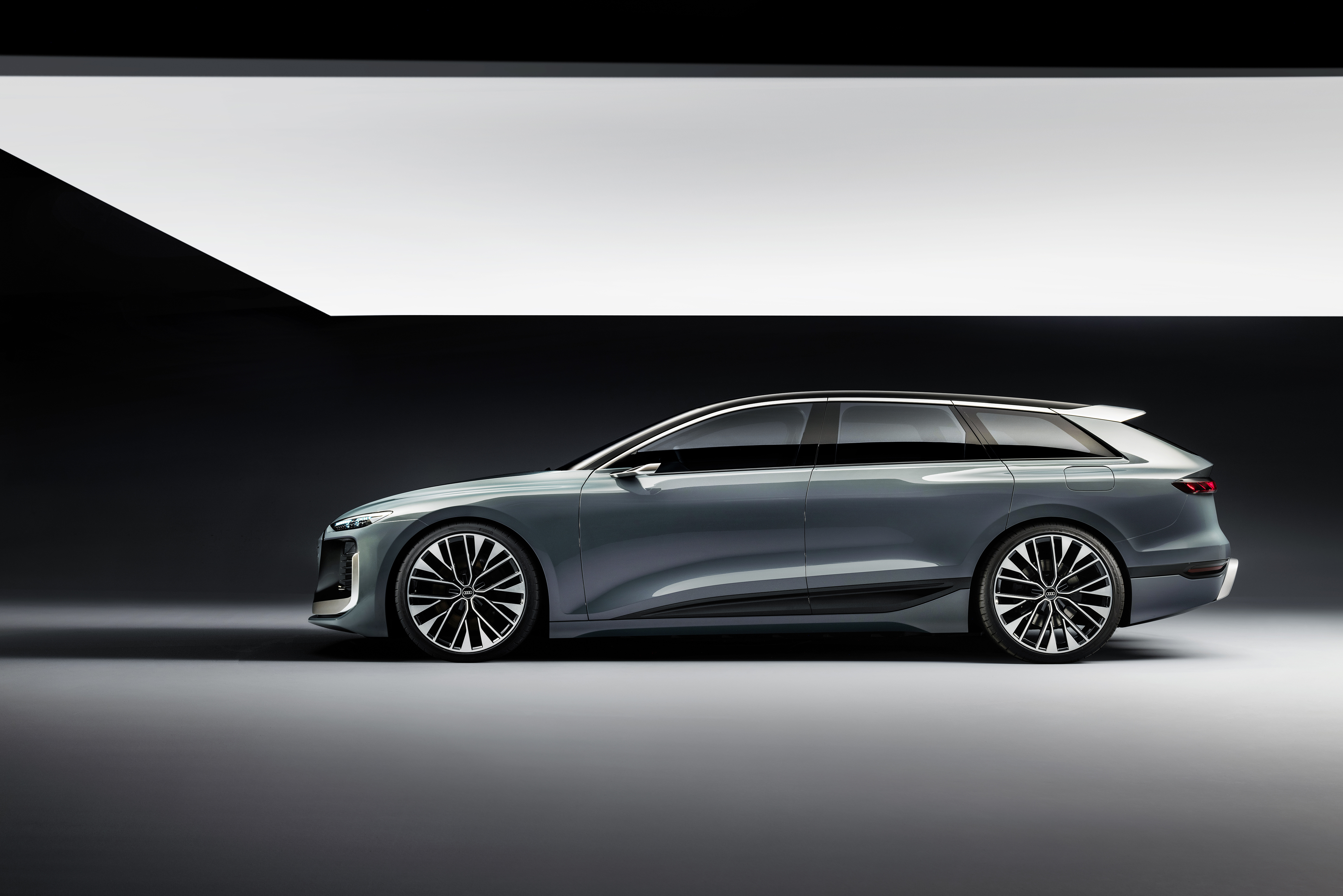
The front grille has an almost sacred status for us.
When people look at the A6 Avant e-tron, the exaggerated “big mouth”, sharp headlights, and front lip form a car with a fierce and personified temperament. From 1968 to 2018, the Audi family-style front face design has been inherited and evolved. Even though the name has changed from “Audi 100” to “Audi A6” and the engineer-assigned codenames have accumulated from C1 to C8, Audi believes that the iconic front face design is the reason people can recognize “This is an Audi” at a glance among the rolling traffic.
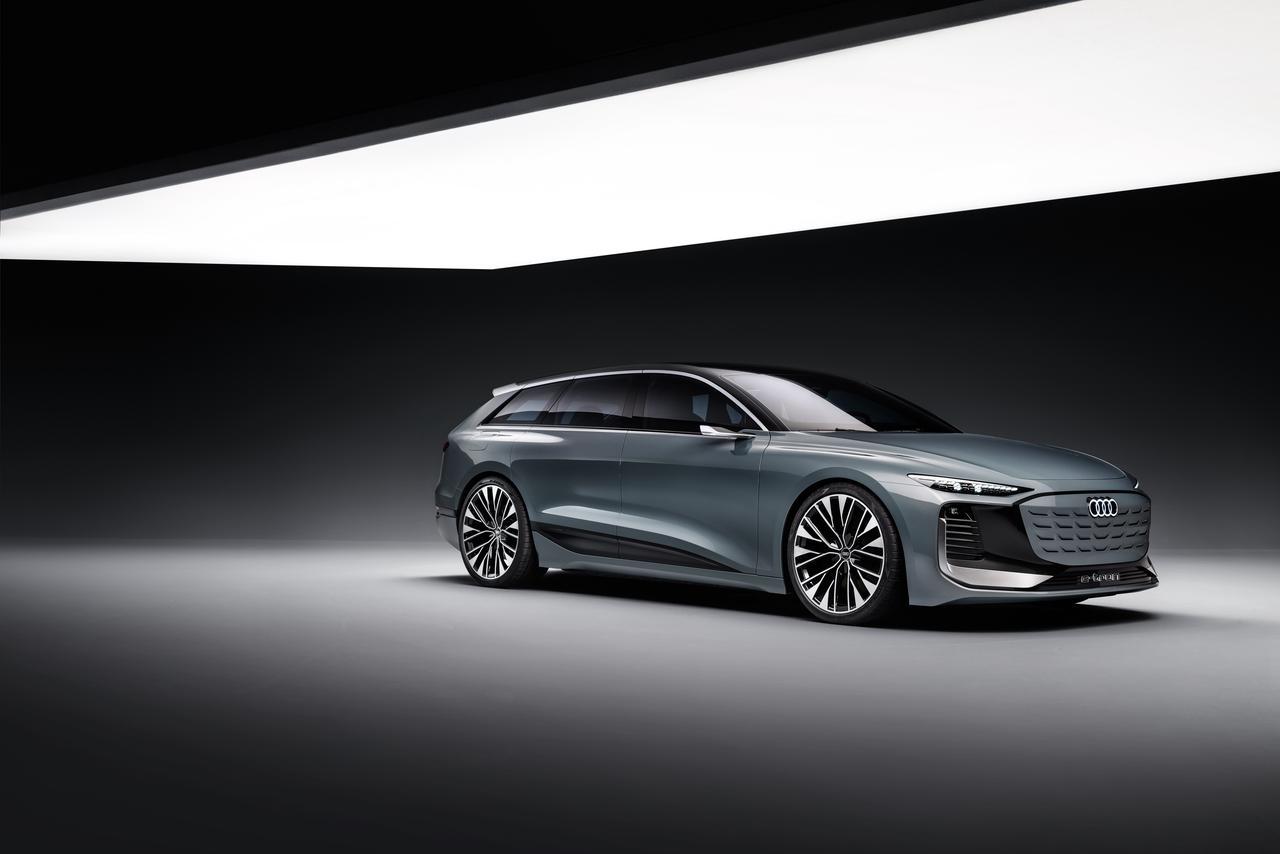
Audi continues to play its excellent tradition of “light factory” and bring some fresh features to the A6 Avant e-tron:
-
Three small high-resolution LED projectors are installed on each side of the body, which can achieve welcome lighting and warning information projection.
-
Four high-resolution LED projectors are set at the four corners of the body, which can project the turn signal on the ground and further improve driving safety.
-
The headlights support cinema-level image projection, and can project game screens on the wall when charging.
-
The taillights can display dynamically.
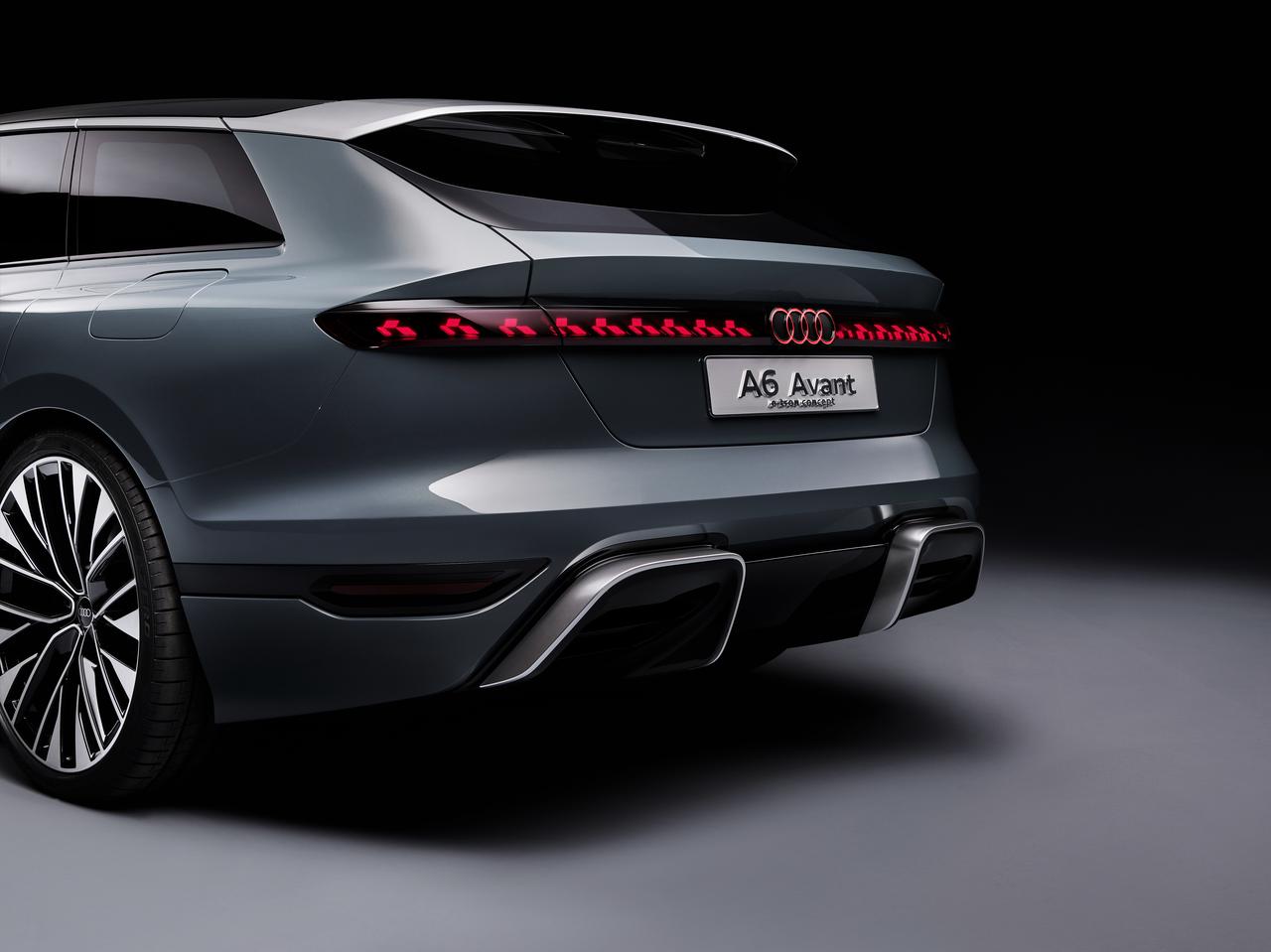
Another member is added to the PPE platform.
The core of the driving technology for each model in the future PPE platform is 800V electrical technology. This technology enables vehicles to achieve up to 270 kW of DC fast charging at fast charging stations, greatly reducing the charging time. This revolutionary technology will enter the high-volume mid-range and luxury car markets for the first time through the PPE platform. PPE platform technology can bring the charging time close to the time required for traditional fuel stops.
In 2019, Audi and Porsche jointly launched the Premium Platform Electric (PPE) pure electric platform, which covers product sizes ranging from B-class to D-class. After the Audi A6 Avant e-tron, Q5 e-tron, and Porsche Macan EV, the A6 Avant e-tron is another powerful member of the PPE platform. In the entire Volkswagen Group’s product sequence, PPE is positioned higher than MEB, which has already launched the ID. series models.
Performance is the fundamental aspect on which the PPE stands out in the fierce competition of the electric vehicle market, and it sets the performance reference for all models derived from this platform.- Ground clearance is 152-217 mm; wheelbase is 2,890-3,080 mm; track width is 1,641-1,741 mm.
- WLTP standard range is 700 km.
- Supports 800V ultra-high voltage charging with a maximum power of 270 kW: charging 300 km of range in 10 minutes and adding energy from SOC 5-80\% in less than 25 minutes.
- The maximum motor output power is up to 350 kW, the maximum torque is 800 Nm, and it supports Audi adaptive air suspension.
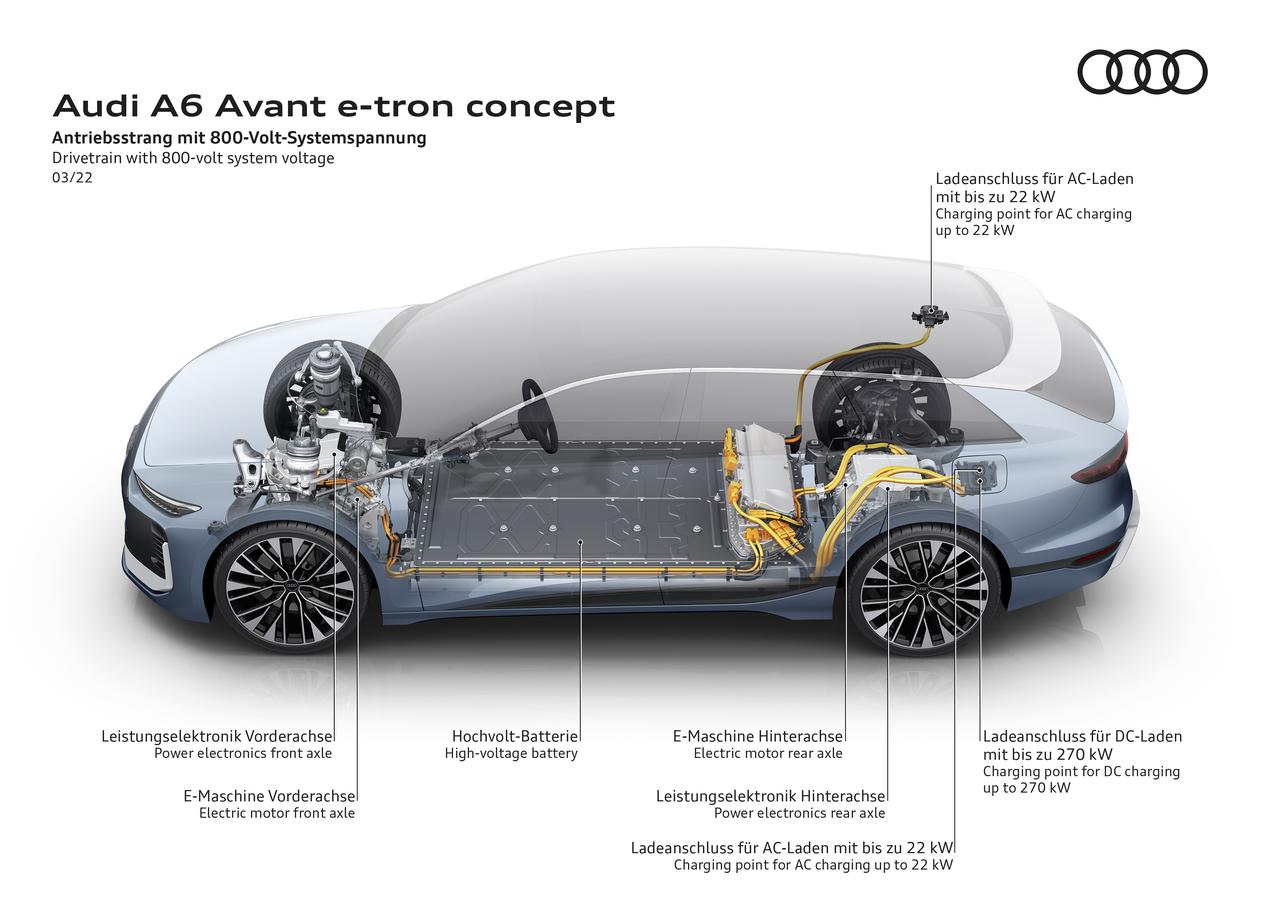
The constant torque characteristic of the electric motor at low speeds is a prerequisite for the five-second acceleration club in the new energy market. However, under high-speed working conditions, the motor power is constant and the output torque gradually decreases as the speed increases, making it difficult to meet the driver’s demand for power. Similar to Audi’s Quattro four-wheel drive technology, the PPE platform has designed a variable gear ratio reducer, which can set i = 8.5 to i = 11.0 up to 4 reduction gear ratios based on the specific product requirements, thereby taking into account the torque output of low and high speeds.
Before the birth of the PPE, Volkswagen Group designed two platforms based on performance and economy respectively: J1 and MEB. The battery pack design of the PPE combines the strengths of both:
- The maximum capacity is increased from J1’s 93 kWh to 100 kWh.
- It integrates the compact and easy-to-produce battery module design of the MEB platform.
- The number of battery modules is reduced from 32 in J1 to the same 12 in MEB.
- It introduces the excellent heat management and 800V ultra-high voltage fast charging characteristics of the J1 platform, with a maximum output power of 475 kW for the battery pack.

The progress of vehicle intelligence breaks the situation where system components operate independently. The E³ 1.1 carried by the Volkswagen MEB platform ID.3 divides the vehicle hardware functions into three parts: vehicle body and chassis, intelligent driving, and information and entertainment services. They are undertaken by ICAS1, ICAS2, and ICAS3 (In-Car Application Server), respectively, and can be updated via over-the-air (OTA) software upgrades for software and functions.Starting in 2023, the PPE platform will be equipped with the more advanced E³ 1.2 architecture, which will be supported by five high-performance computers (HPC) rather than the original three vehicle application servers. The platform will cover all vehicle functions and areas, from information entertainment to driving functions and even to autonomous driving. This system will enable software upgrades from entertainment systems to chassis.

A large amount of road test data is necessary to perfect autonomous driving. Therefore, the PPE platform has designed a “big circle” of data that goes from vehicles to the cloud and back to vehicles. The data collected by vehicles is used for model training in the cloud, and as cloud AI evolves, the vehicles can continuously improve using the iterative process.
The Willow Knows the Buddha: the ambition of launching a new platform’s first travel car
Following the “NEW AUTO” strategic timetable released by Volkswagen Group in July 2021, the Audi Artemis in 2025 will become the complete E³-the Scalable Systems Platform (SSP). SSP consists of multiple functional modules with the same interface, including electronic and electrical architectures, autonomous driving, battery systems, and intelligent cockpit, among others.
After 2025, Volkswagen Group plans to satisfy the design requirements of “compact and economic cars, high-performance SUVs” by combining the eight different functional modules under the SSP architecture. Based on the high-performance computers supported by SSP architecture, vehicles can create their own “metaverse”. The data generated by driving is fed into the metaverse to calculate and predict real driving conditions, recognize the reaction of other traffic participants, compare it with the behavior of human drivers, and ultimately train autonomous driving functions.

Despite rare cases of mass production or conceptual vehicles, few other electric vehicles start with the travel car form, as seen in other automakers. During the gasoline-powered car era, voices questioning the purpose of travel cars continuously resounded: for comfort, SUVs have more spacious interiors. For handling, the iconic tailgate of the travel car is not ideal for chassis tuning.
The new “Neptune Valley” car paint, with a warm gray tone, highlights the sporty temperament of the model. When the car is driving in darker places, its appearance is modern and low-key. However, when driving in the sunlight, the full effect of the car paint will be revealed, and the car will look like wearing a soft and golden rainbow veil.
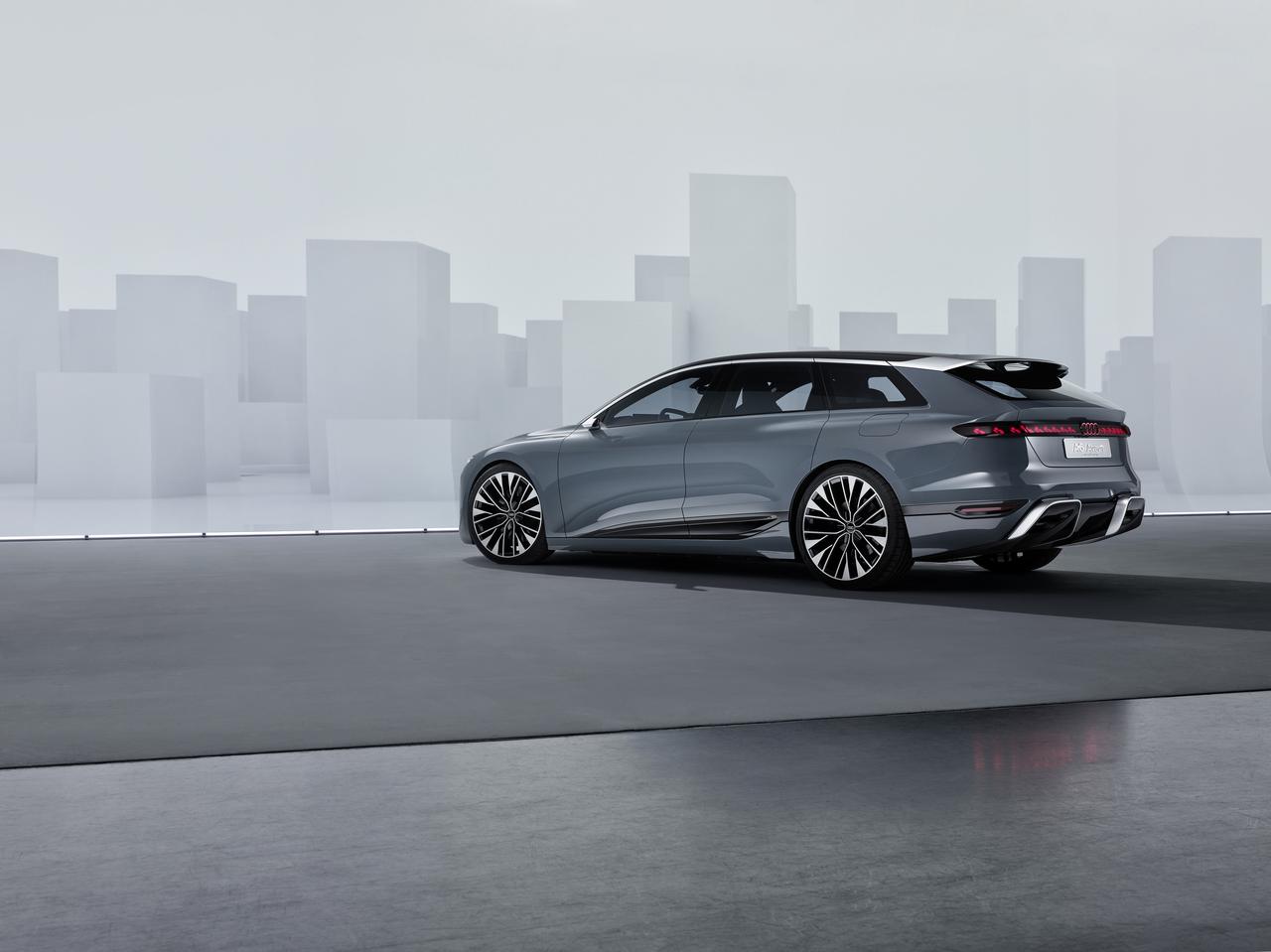 The A6 Avant e-tron’s choice of low-saturation paint color, which resembles the flagship A8 Horch’s Oak Green, as well as the host’s grey olive linen jacket and the naming of “6” in the family sequence, all showcase its high-end status. Perhaps in Audi’s view, the A6 Avant e-tron is a declaration of its pursuit of design in the electric age, striving to hit the audience in the heart. The high-end positioning of the product line gives the A6 Avant e-tron the confidence to not compromise on design.
The A6 Avant e-tron’s choice of low-saturation paint color, which resembles the flagship A8 Horch’s Oak Green, as well as the host’s grey olive linen jacket and the naming of “6” in the family sequence, all showcase its high-end status. Perhaps in Audi’s view, the A6 Avant e-tron is a declaration of its pursuit of design in the electric age, striving to hit the audience in the heart. The high-end positioning of the product line gives the A6 Avant e-tron the confidence to not compromise on design.
Coincidentally, the ID.ROOMZZ on the next platform down, as well as Project Trinity, whose SSP platform has only a rough outline, are both designed as station wagons. Choosing station wagon design not only fulfills Audi’s historical sentimentality but also may be due to the large hurdle facing all manufacturers in the electric age – the battery.
A simple calculation shows that the energy of 1 liter of gasoline is about 10 kWh. As a result, a pure gasoline car with a fuel tank capacity of 40 liters has 400 kWh of available energy – without needing to fill the chassis with batteries and occupy passenger space.
Faced with the constraints of battery energy density, preserving the design of the vehicle requires sacrificing interior space, while compromise on range requires increasing vehicle size. For the proportion design of a sedan, raising the floor too high would destroy the proportion. The more flexible configuration of a station wagon leaves more room for vehicle design, which may be another practical factor for Audi’s determination to launch the A6 Avant e-tron.
Audi still regards the A6 Avant e-tron’s interior design as confidential. However, by comparing the GrandSphere concept car design and the A6 e-tron concept design sketches, we may be able to find some clues.
The interaction between the GrandSphere and the driver is not so “bright and shining.” Audi’s existing MMI system chooses to provide an additional dimension of touch operation through vibration. At present, when touch screens are exploding in cars and even occupying a central position, Audi’s designers have chosen a more tactile way – texture.
 The ups and downs on the fingertips of the operator’s skin have a touch that far surpasses all simulated vibrations: by recognizing commands through gestures, rotations, and rubbing in the sensing area, corresponding controls are completed.
The ups and downs on the fingertips of the operator’s skin have a touch that far surpasses all simulated vibrations: by recognizing commands through gestures, rotations, and rubbing in the sensing area, corresponding controls are completed.

One of the selling points of the Pixel 4 series phones released by Google in 2019 is “Motion Sense” – precise finger movements are recognized through a small radar in a certain space range. This technology may have another use in the automotive human-computer interaction design.
One of the subsidiary characteristics of electrification is high performance. When asked whether the RS series will continue to exist, the guests on the scene gave an ambiguous answer:
We think the performance of the A6 Avant e-tron is enough to satisfy people’s needs for driving pleasure.
The dilemma of self-owned product brothers is posing new challenges to manufacturers: in the era of oil cars, Mercedes-Benz has AMG, BMW has the M department, Ford has the Mustang, Volvo has Polestar… In the context where power has become relatively easy to obtain, how to make existing product subclasses maintain their unique characteristics will be a problem that car companies with performance departments need to consider.
Mercedes-Benz and BMW choose to continue to retain performance brands and further strengthen them in hardware and experience; Ford regards electric performance as an extension of Mustang; Polestar is a separate portal, detached from Volvo’s product line – the choice of Audi remains to be seen.
Another possibility is that the RS series of Audi is still the representative of internal combustion engine performance. Audi stated at the press conference that considering the differences in charging conditions and infrastructure around the world, they will still launch new gasoline and hybrid models, but Audi will no longer develop new platforms for internal combustion engines.
Perhaps the current designs with emerging “platforms” and “architectures” will eventually converge: all functional data computations will be handed over to the central computer through standardized interfaces, and intelligent hardware can also be updated and iterated like changing a SIM card. The entertainment app tested internally tonight can be downloaded on schedule, the intelligent firmware planned to be released next week can provide a base for all vehicles to implement more functions, and the new hardware unit to be launched in the market next year can be used simply by inserting it into the corresponding card slot – the new modularization under the background of intelligent cars.

This article is a translation by ChatGPT of a Chinese report from 42HOW. If you have any questions about it, please email bd@42how.com.
